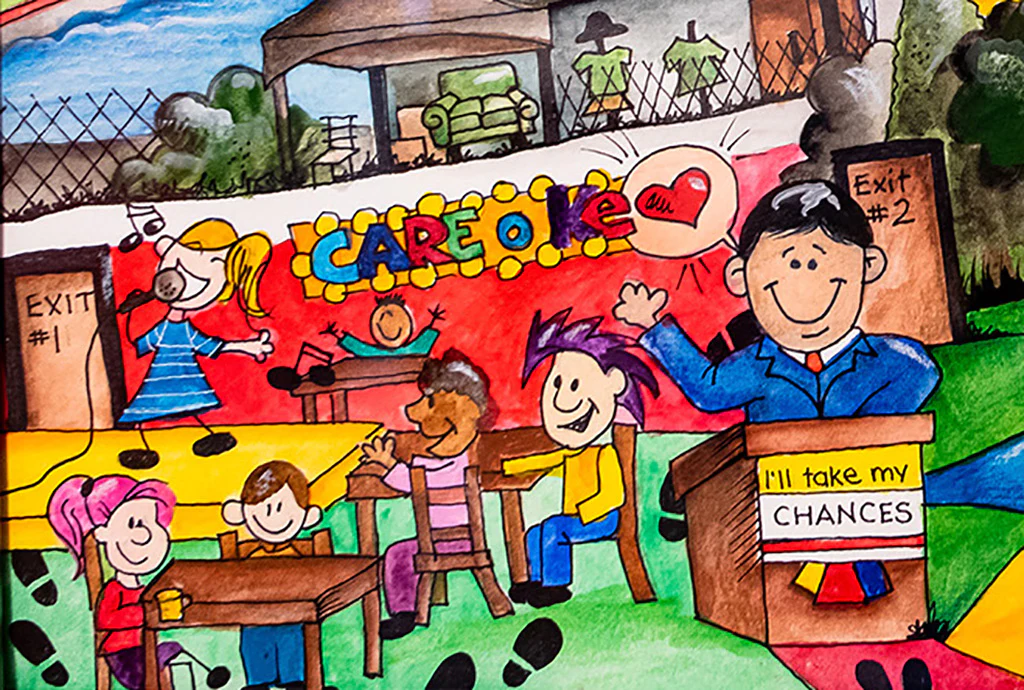What Makes a Safe Space?
For the purpose of city planning, it is common to “map” all the resources within a given area – roads, waterways, traplines, etc. Maps make things visual and, unlike 600-page reports (that no one reads), visuals invite us to gather, to interpret, to find meaning. Not only do maps allow us to see where things are, they also tend to reveal where things aren’t and how best to fill those gaps if, together, we decide those gaps are important.
Last spring, I made a map. Instead of physical resources, I was invited to doodle social-emotional resources. More specifically, LGBTQ2S+ people were asked to illustrate our sense of safety in downtown Salmon Arm.
This exercise is called Cultural Mapping. The written report vs. colorful map is not insignificant for one of its founding principles is equity. Not only does drawing make data accessible, but it invites the input of true stakeholders. Don’t know about you but I’ve never seen a lively huddle around a 3-inch binder.
My map contains a secret unit of measure against which all other Salmon Arm businesses are compared. In the bottom left corner, occupying nearly a quarter of the page and the only building showing its interior, is Chances, Salmon Arm’s casino.
For me, the "safe space" sticker in a business window functions like a question, not a promise.
It’s not saying we are a safe space; it’s asking are we a safe space? Come inside and decide for yourself. The sticker is not a declaration but an exploration. To what extent does this business live up to its claim? In my map, the casino checks most of the boxes, mostly because of karaoke.
Before we walk the casino floor, I should probably explain the role of karaoke in the queer community. It’s a big deal. For all the ways a bar might seek to identify itself, narrowing its nightly focus to a genre and the type of people it likes to serve, karaoke – for one night – erases all those lines.
Queer folk love erasing lines. You can rap your face off at a country bar in Grindrod. This prairie girl belts out Shania Twain in downtown Vancouver.
It is not the purpose of karaoke to feature the best voices. In truth, bad singing is inherent to karaoke; it is expected (thank god). Hosted well, the audience quickly learns the importance of unconditional encouragement. If you can’t cheer a bad singer, then you don’t belong at karaoke. Go home, asshole. The nature of karaoke is inherently diverse and inclusive. So, this brings us back to Chances in Salmon Arm …
First, there is a greeter. At the casino, there is someone at the door acknowledging each person as they enter, and that makes me feel safe. That these greeters often belong to a marginalized group adds to my sense of inclusion. If I am deep in a store when the bell jingles, I am comforted when I hear staff greet the newcomer. We’ve all been seen. The cheery flight attendant is sizing up terrorists as much as anything. Once inside, the casino is remarkably free of doors and not only is the entrance into the restaurant wide and unobstructed, there are two of them, one on either side of the stage.
Exits matter to marginalized folk. So do walkways, lighting and spaces between tables.
Other than the booths, the tables at Chances aren’t fixed to the floor. Moveable tables are inherently inclusive, particularly when your gaydar is working and you spot someone sitting alone. Chair after chair, our table expanded to include seniors, singles, people with disabilities, visible minorities, and other general oddballs like me.
There are bathrooms on my map. At the casino, bathroom doors are labelled with words and letters I don’t recognize. It’s a magnificent feeling. It’s a lovely non-white, non-English feeling to see words I can’t read. It means someone other than me pees there.
I am cis-gendered which means I am in agreement with the assignment I was given at birth. I am also "passing" which means, other than my girlfriend, there are few identifiable features to my orientation. All on my own, I am not likely to be targeted.
In pink plaid and mascara, my expression is more feminine than not. 0/3, this makes my sense of safety a pretty sure thing compared to others within my queer family. Truth is, I am not just measuring safety for my own sake; I represent a community.
In the early stages of diversity learning, symbols tend to be taken at face value, taken literally. What do you mean you don’t feel safe here!? We have a Safe Space sticker! A little further into diversity training, participants are likely to discover subtler clues of safety, a broader definition, a wider-cast net. As a queer person, I am not only looking for signs that “my people” are included but that all people are included. And not only people but values related to animals and the environment. To me, “don’t leave your pets in the hot car” is as much a sign of inclusion as a rainbow flag
Karmen Krahn serves as Behaviour Consultant to School District #83. Karmen and her pups live minimally in 300 square feet with art supplies and tennis balls. In all its forms, Karmen's passions are collaboration and inclusion.


